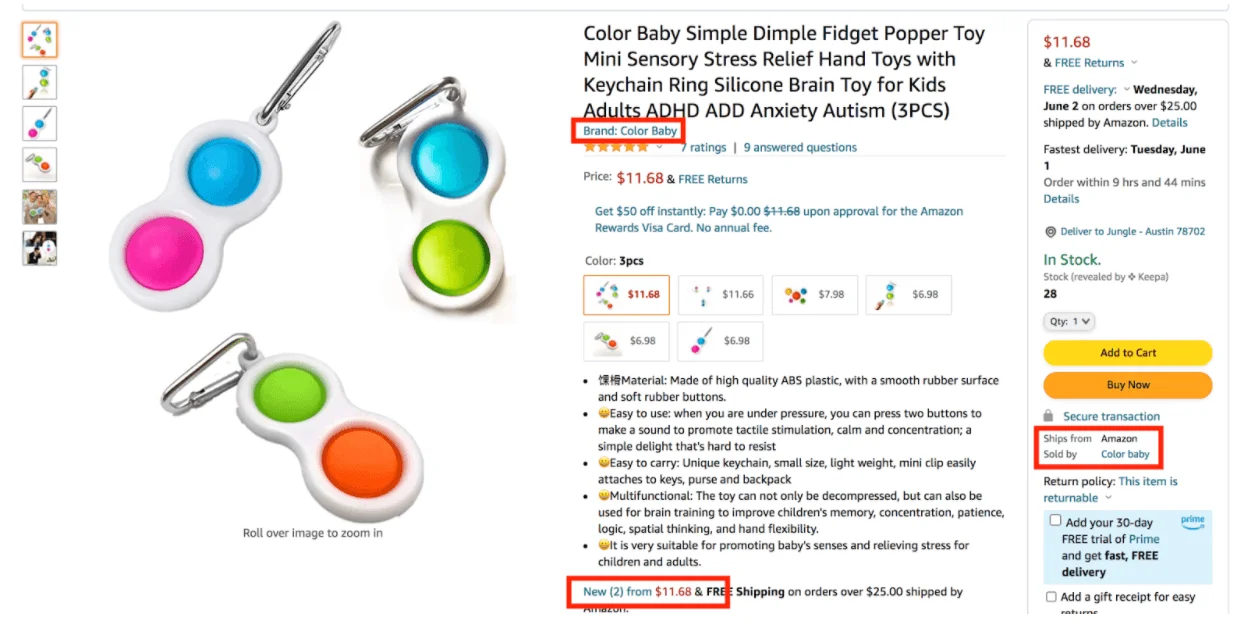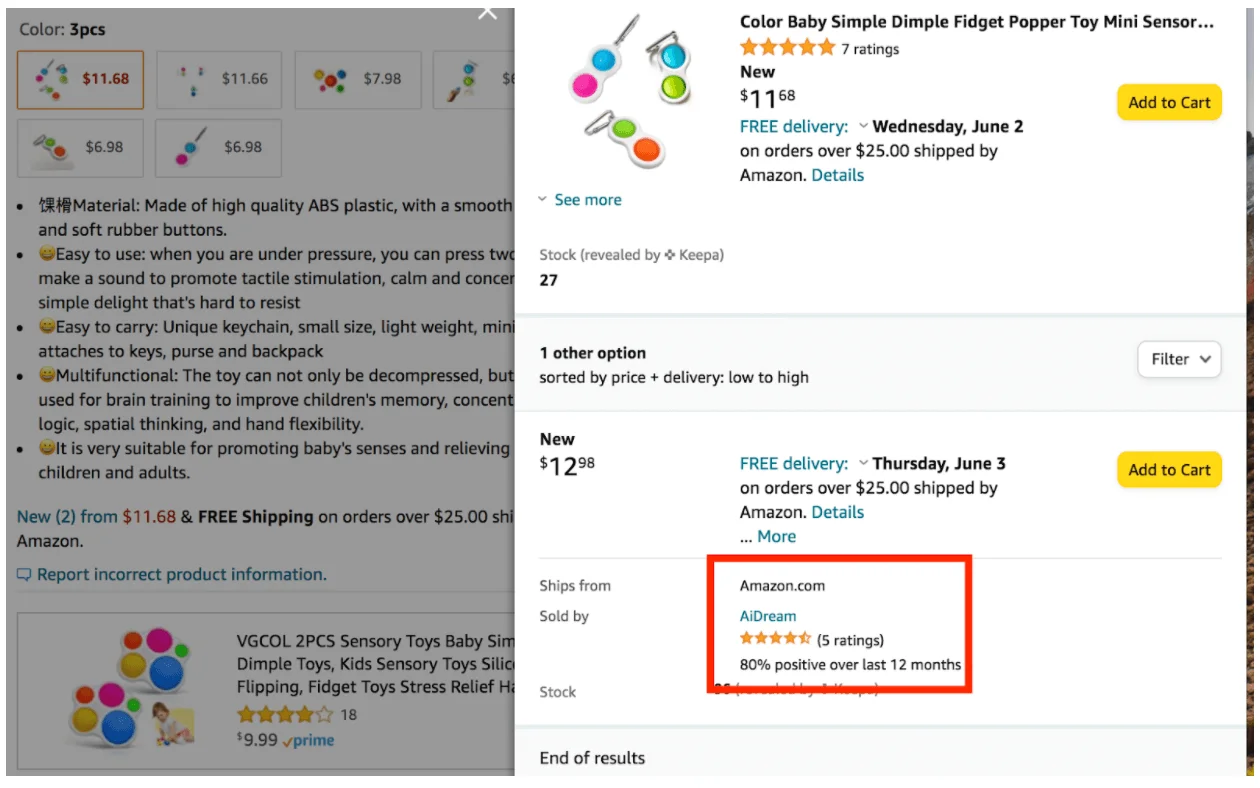Table of Contents


Therefore, this article will discuss a common issue that almost every successful Amazon seller has faced. So, what is an Amazon hijacker? How to stop Amazon hijacking listings?
What is Amazon listing hijacking?
It means that some people sell counterfeit products or similar versions of your private-label goods. It is incredibly frustrating to a private-label Amazon seller. They took the effort to develop their brand and products on Amazon specifically to avoid competition with other sellers and control the Buy Box. Having their listing “hijacked” is a crucial concern among sellers on Amazon. According to the State of the Amazon Seller Report, 48% of merchants are worried about hijackers developing copycat listings.
Protect Your Amazon Business with SellerSonar
Effectively tracking and addressing Amazon hijacking manually can be a daunting task, particularly with a large number of listings. SellerSonar provides an invaluable solution by offering automated hijacking alerts. By continuously monitoring your listings, SellerSonar promptly notifies you of any changes or unauthorized sellers detected, allowing you to take immediate steps to protect your brand and maintain control over your listings.
Furthermore, SellerSonar offers the convenience of exporting daily tracking data, providing a comprehensive summary of your listings. With this feature, you can determine the number of merchants offering your products and their corresponding prices. By comparing these statistics, you can quickly identify if you are facing any hijacker issues. The exported file compiles all alerts, including relevant information such as ASIN, marketplace, and alert type. Utilizing filters, you can easily sort and analyze the data according to your specific needs.
Register for a free 29-day trial today and discover how SellerSonar can revolutionize your Amazon selling experience.
Example of hijacking
Let’s take a closer look at how this issue appears on the platform, so you can easily spot its signs. For instance, we’ve found a product listing for a fidget popper toy with two different sellers. Since it is a private-label item, it should have one seller.


We highlighted several sections on the product detail page that show the listing might have been hijacked: the brand, the Sold by and Ships from information, and the section at the bottom of the description bullets that contain “New (2) from $11.68…”. It can define two or more Amazon sellers on this product listing.
As the seller and brand names match, we know this item is a private label. So, there are a few reasons why there might be more than one seller on this private label listing.
- The owner of the brand approved another Amazon seller.
- The other seller bought these products from some coupon site and is reselling them.
- The other seller is selling counterfeit goods and is hijacking the product listing.
When we click on “New (2) from $11.68,” you can see a screen that shows all of the Amazon sellers on this listing. It is indicated that the original offer for this item is from the brand named Color Baby, which controls the Buy Box.


Once you look below Color Baby’s offer, you can see that another seller is Aidream. Such a seller has an overall rating of 80%, which is not bad, but it is not great— another sign that this might be an Amazon listing hijack situation.
Side note: As an Amazon seller, you should strive to keep your seller feedback as close to 100% as possible.
The evidence seems that AiDream has hijacked product listings and is attempting to sell counterfeit or generic versions of the Color Baby products under the Color Baby brand — even when they don’t have stock of the original goods.
Please note that this is just an example — if AiDream turns out to be an authorized seller of Color Baby goods, this wouldn’t be a true case of listing hijacking. However, you can utilize the same clues to check whether other sellers have hijacked your Amazon listing. For example, if you see someone competing with you for your Buy Box and you have not authorized it, you are likely to have been hijacked.
What is the influence of hijacking?
A hijacked listing can impact both your bottom line and your customers.
Imagine this: an unsuspecting client buys your product. However, instead of getting an original item from you, the following happens: your hijacker on Amazon owns the Buy Box, receives the sale, and the client gets a counterfeit item. Dissatisfied with their purchase because of the poor quality, the shopper shares a negative review on your product listing. You receive a bad testimonial for something that you do not even sell, discouraging prospective visitors from buying your goods. How frustrating!
How to get rid of Amazon hijackers?
How to remove Amazon hijackers? A smart yet simple strategy on how to deal with Amazon hijackers is all you might need. Below are five efficient ways to secure your listing and enhance your Amazon business at the same time:
- Track your listings closely
Beyond just monitoring your Amazon Seller Central account every day, you will wish to check your listings from your clients’ point of view. First, look at the listing to check how many Amazon sellers offer your private-label products. If it is more than one (that single seller should be you!), then you might have a hijacking situation on your hands. Of course, you do not need to track your listings every day — every week is enough, especially when your sales start to rise and competitors notice your success.
- Create your website
Suppose you can create your digital channel outside of the Amazon platform (there are many sites that make it easy to develop your online business store). In that case, you can boost your business against Amazon FBA hijackers. In addition, if you can verify your business with your website, it adds up to trust and credibility with your clients, and you will always have some home base outside of the marketplace to sell your products online.
- Promote your brand better with Amazon Brand Registry
You might deter the lurking pirates when you create proper branding on your product listings and indicate that you have a distinct seller brand and logo on the products and packaging. You will be displaying your brand identity to the clients, and if they order your goods from some counterfeit seller, the client will be able to promptly recognize that what they are purchasing isn’t the same brand as yours.
When taking photos of your product, try to show off your branding on the product itself and packaging. Whether you started your business or are an experienced seller, it’s the best practice. You have been working hard to develop your brand, so show it off proudly to your clients!
The next thing Amazon sellers should do is send a polite letter to the hijackers requesting them to take down their listings.
Here is an example of the email you can write:


If the seller does not reply, report infringement to Amazon to block hijackers.
The platform has Anti-counterfeiting Policies you can find on the Amazon page with help files that make clear that the marketplace doesn’t tolerate the selling of counterfeit products. Here’s exactly what Amazon says:
- Once you follow the “notify us” link, you will be taken to the platform’s Report Infringement policy and form. Fill in an infringement claim and file a complaint.
- Within 24 hours, such an offer will be deleted. You’ll get a notification from the Seller Performance Team on Amazon notifying you that the “product listing you mentioned…appears to have been deleted from the platform. We believe this will bring this issue to a close.”
Another method exists to report the sellers to Amazon under the platform’s counterfeit policies. Have your friend purchase the product and send an A to Z claim to Amazon.
Below are the exact steps on how to report a hijacker on Amazon:
- Ask your friend (it shouldn’t be a relative) to purchase the goods in question.
- Wait for the products to be sent and received.
- Ask your friend to complain to that merchant that the product is fake through the Amazon section, where you can report a problem. Select the variant about the goods not being the same.
- Wait for 24 hours and send a comprehensive request against your counterfeit seller.
- Be sure to use the words “fake,” “counterfeit,” or “not authentic” in your claim to Amazon.
- If everything goes well, the platform will remove the hijacker’s listing within a couple of days.
How to monitor my Amazon listings for hijackers?
How to protect Amazon listings from hijackers? Unfortunately, you cannot prevent hijackers from trying to damage your business. However, you can react promptly and efficiently to all their malicious actions by tracking your product listings and receiving instant alerts of any listing violation, listing hijacking on AMZ, and unauthorized changes. This is where SellerSonar comes in, securing you from all the black hat tricks.
How to prevent AMZ listing hijacking? SellerSonar immediately sends you notifications of any changes to the Amazon listing or crucial account metrics. It includes the following common issues: listing hijacking, adding prohibited words to your product description, changing titles, manipulating reviews, and many other threats.
Try SellerSonar’s 29-day free trial and start protecting your listings today.
